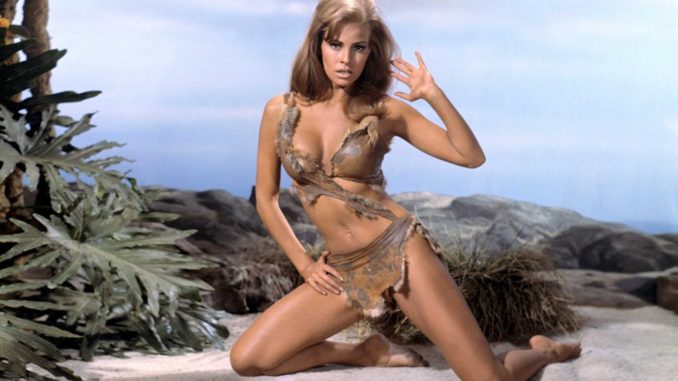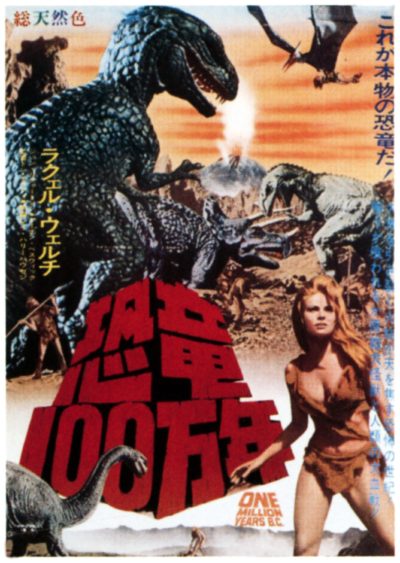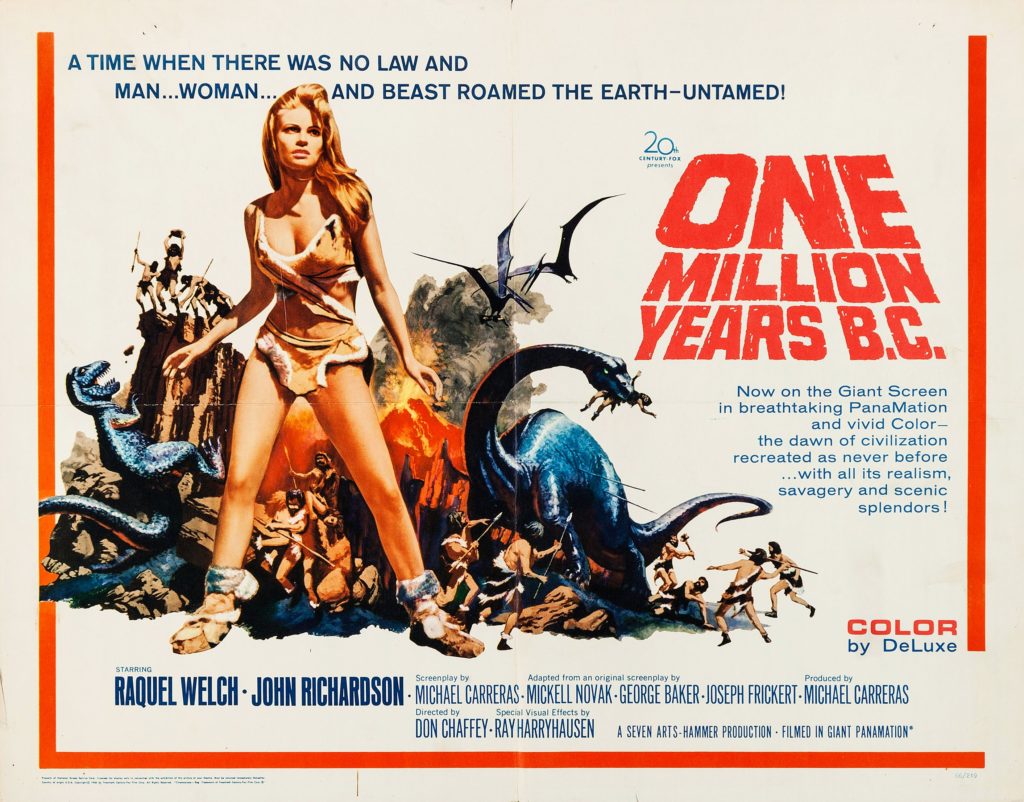
Rating: C+
Dir: Don Chaffey
Star: John Richardson, Raquel Welch, Percy Herbert, Robert Brown
By some measures, this was Hammer’s biggest hit, grossing close to twenty times its budget in the United States alone. I doubt many people would call it their best, even it was arguably the starting point for a studio “franchise”, every bit as much as Dracula or Frankenstein. It’s certainly iconic, and some elements have stood the test of time very well. But if those aspects deserve praise, it must also be admitted that this is a film with copious flaws. Most obviously, it has 30 minutes of worthwhile content, scattered across 96 minutes (in the uncut PAL DVD).
The most obvious positive is Raquel Welch. “THAT” promo picture is perhaps the most well-known from any Hammer movie – not least for its guest role in The Shawshank Redemption. She’d had previous movie roles, and just made Fantastic Voyage, but this movie catapulted her to stardom. As she put it, “I was the dinosaur lady first and the science lady second.” However, she wasn’t the studio’s initial choice. They had wanted Ursula Andress, who had starred in She, but negotiations broke down over pay. Though Welch was then under contract to Fox, they agreed to loan her to the British studio. She wasn’t initially enthusiastic, and had to be convinced by studio head, Dick Zanuck. He told her, “You’re going to do it, and you’re going to become a huge star.”
 It may be the ultimate case of screen presence, in its purest form, in the Hammer filmography. And considering what Christopher Lee did as Dracula, often with barely a handful of lines, that’s an impressive feat. The director, however, was not very keen on receiving Raquel’s artistic input:
It may be the ultimate case of screen presence, in its purest form, in the Hammer filmography. And considering what Christopher Lee did as Dracula, often with barely a handful of lines, that’s an impressive feat. The director, however, was not very keen on receiving Raquel’s artistic input:
I went to the director, Don Chaffey, very early in the shoot and said, “Don, may I have a word with you?” And he sighed and said, “Yeah, what is it?” I could tell right away that he was not very interested. “Well, I’ve read the script,” I said, “and I’ve been thinking…” And he turned to me and said, “Don’t… See that rock over there? That’s rock A. When I say action, you run from rock A and when you get to the middle of the frame, you look up at the sky like there’s a giant turtle growling down at you. You scream, run to rock B and we break for lunch.”
The other factor which still works very well are Ray Harryhausen’s stop-motion effects. Early on, the film uses enlarged footage of actual animals, like an iguana and a tarantula. This was intended to ease the audience into the more fantastic elements. But what it does, is provide something against which Harryhausen’s work can be measured. And after a frankly ropey giant turtle, it’s one glorious set-piece after another. The young Allosaurus invading the cavemen camp. The Triceratops vs. Ceratosaurus battle. Duelling Pterosaurs, fighting over who gets to eat the Raquel McNuggets. They are all wonderful. I’d say, in terms of bringing dinosaurs to life, this likely wasn’t surpassed until Jurassic Park, more than a quarter-century later. I also want to mention the volcanic eruption at the end, a well-rendered bit of disaster porn, about which I’d largely forgotten.
The above is not all the film has to offer – I’d also give a passing nod to Martine Beswick’s bad girl. But it’s easy to forget that this is not Welch’s film. Early on, frankly, it is a bit of a slog, with cavemen Sakana (Herbert) and Tumak (Richardson) falling out, literally, over hog lumps, and Tumak going over a cliff. Surviving, he staggers through a blasted, volcanic landscape (shot in the Canary Islands), until he reaches a beach, where he collapses, conveniently close to Loana of the Shell People. But we don’t even see her until almost half an hour into proceedings. There’s a reason the narrator says at the beginning, “This is Akhoba, leader of the Rock tribe. These are his sons, Sakana and Tumak. There is no love lost between them. And that is our story.” Any fur bikinis or stop-motion reptiles – y’know, the fun stuff? – are notable by the lack of a mention.

We’d discussed Richardson before, in our review of She, when we called him “just another example in the ongoing series of blandly uninteresting Hammer young male leads.” There’s little or nothing here to change that perception, though at least his grunting is in line with the rest of the cast. Hardly has he settled in with the Shell People, than Tumak is involved in another brawl, and is asked to leave. [What’s the saying? “If all you meet are assholes… maybe you’re the asshole.”] Loana goes with him, though it’s a decision her facial expressions suggest she quickly regrets, as we’re back to extended trekking through the blasted, volcanic landscape once more, back to the Rock People. Mind you, given the Shell People appear to have access to hairdressers, dental hygienists and hot water, all concepts unknown on Planet Rock, I can’t blame her.
They rejoin the Rockettes, though Tumak’s former girlfriend, Nupondi (Beswick), is unhappy to find him now hanging out with a blonde who has better dress sense. What follows is the prehistoric equivalent of unfriending on social media, and is likely another well-remembered scene. Thereafter, Loana gets abducted by a Pteranadon, there’s a rebellion among the Rock People, in which the Shell People get involved, and right in the middle of that fight, the volcano goes off. Many, many people fall into chasms, and the landscape becomes even more blasted. The end sees the remnants of the two tribes united under Tumak, and heading off to an uncertain future. Or international stardom and a place on many teenage boys’ walls, in the case of Loana.
Chaffey had previously worked with Harryhausen, directing another renowned project, Jason and the Argonauts, so his disdain for Welch’s “thinking” is perhaps understandable. However, perhaps the most telling point is the promo material, some of which you can see here. If the director may have been ambivalent about his leading lady’s talents, the same can certainly not be said for Hammer’s publicity department: almost without exception, everything has Welch front and centre. Richardson? Equally notable by his absence. Just don’t expect the movie to reflect quite the same ratio, and you’ll be okay.
This review is part of Hammer Time, our series covering Hammer Films from 1955-1979.
